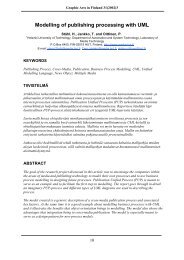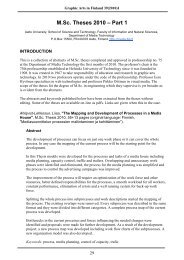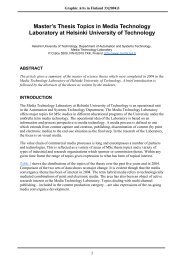Client-Side Storage in Web Applications
Client-Side Storage in Web Applications
Client-Side Storage in Web Applications
You also want an ePaper? Increase the reach of your titles
YUMPU automatically turns print PDFs into web optimized ePapers that Google loves.
Silo was evaluated with multiple real-world websites, such as CNN, Twitter, andWikipedia. Based on their experiments, Silo can reduce web page load times by 20-80% for web pages with large amounts of JavaScript and CSS.4.3 Other Projects<strong>Client</strong>-side storage mechanisms have also been used to solve other usage scenarios.Cannon and Wohlstadter [6] implemented an automated object persistence framework,which reduces the amount of work needed by developers to support offl<strong>in</strong>e webapplications. Ijtihadie et al. [13] presented a prototype of an offl<strong>in</strong>e mobile web applicationfor synchroniz<strong>in</strong>g quiz for e-learn<strong>in</strong>g activities, which was built upon Offl<strong>in</strong>e<strong>Web</strong> <strong>Applications</strong> and <strong>Web</strong> <strong>Storage</strong>.5 ConclusionIn this paper, dist<strong>in</strong>ct approaches for stor<strong>in</strong>g and manag<strong>in</strong>g data on the client sidewere covered. For a long time, simple HTTP cookies were the only considerable optionand they were ma<strong>in</strong>ly used for session management due to their limited storagespace. The emergence of (Google) Gears revolutionized the area with its "unlimited"storage space and rich set of features, which also paved the way towards standardiz<strong>in</strong>gclient-side storage mechanisms.Currently, the W3C provides three API proposals for persistent (session or local)data storage: <strong>Web</strong> <strong>Storage</strong>, <strong>Web</strong> SQL Database (deprecated), and Indexed DatabaseAPI (IndexedDB). <strong>Web</strong> <strong>Storage</strong> offers a simple key-value pair data storage mechanismsupported by all major browsers, whereas IndexedDB <strong>in</strong>cludes a number ofadvanced features but is still a work <strong>in</strong> progress. Both mechanisms clearly have afuture, as their scopes and benefits are dist<strong>in</strong>ct as well as they can be used to complementeach other. Recent studies have also shown how the usage of client-side storagemechanisms can significantly improve both the performance and user experience of(mobile) web applications.References1. Adobe. An Update on Flash Player and Android. June 2012.https://blogs.adobe.com/flashplayer/2012/06/flash-player-and-android-update.html.2. Adobe. What are Local Shared Objects? 2012.http://www.adobe.com/security/flashplayer/articles/lso/.3. Barth, A. (eds.). HTTP State Management Mechanism. IETF RFC 6265 (Standards Track),April 2011. http://tools.ietf.org/html/rfc6265.4. Barth, A. (eds.). The <strong>Web</strong> Orig<strong>in</strong> Concept. IETF RFC 6454 (Standards Track), December2011. http://www.ietf.org/rfc/rfc6454.txt.5. Benson, E., Marcus, A., Karger, D., and Madden, S. Sync Kit: A Persistent <strong>Client</strong>-<strong>Side</strong>Database Cach<strong>in</strong>g Toolkit for Data Intensive <strong>Web</strong>sites. In Proceed<strong>in</strong>gs of the 19 th Interna-13
















